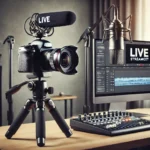Understanding the Difference Between Streaming at 30fps and 60fps
Video quality matters more than ever in today’s digital content world. As creators focus on advanced streaming techniques, one of the most debated topics is frame rate — specifically, 30fps versus 60fps. Your choice can directly affect viewer experience, bandwidth usage, and overall engagement.
In this guide, we’ll break down the practical and technical differences between 30fps and 60fps so you can make an informed decision for your live broadcasts or VOD content.
Why Frame Rate Matters in Streaming
Frame rate, or frames per second (fps), refers to the number of individual images displayed every second in a video. It plays a crucial role in determining how smooth, life-like, and professional your video appears. Streamers and video producers aiming to leverage advanced streaming techniques often grapple with whether to stream at 30fps or 60fps.
The choice impacts file size, CPU load, streaming latency, and hardware requirements — all essential factors to consider if you’re targeting quality and viewer retention.
Common Challenges with Selecting the Right Frame Rate
Choosing between 30fps and 60fps is not a one-size-fits-all decision. Here are a few common issues that creators encounter:
- High CPU Usage: Streaming at 60fps can double the CPU load, leading to dropped frames and poor video performance if your setup isn’t optimized.
- Bandwidth Limitations: Higher frame rates produce more data, requiring better upload speeds. This can result in buffering or quality downgrades if your connection is unstable.
- Platform Restrictions: Not all streaming platforms handle 60fps well under all conditions. For instance, Instagram Live may not support it natively, while YouTube and Twitch do.
- Viewer Device Compatibility: Some viewers might be using devices that can’t render 60fps smoothly, resulting in playback issues.
Understanding these hurdles helps you fine-tune your advanced streaming techniques and avoid pitfalls in your content strategy.
Comparing 30fps vs. 60fps: Which One Works Best?
To determine which frame rate suits your content, consider the type of content you produce, viewer expectations, and your technical infrastructure. Let’s explore these in depth.
Motion Clarity and Viewer Experience
- 30fps: Suitable for interviews, talk shows, casual vlogging, and webinar-style content. It simulates traditional television frame rates and is easier on system resources.
- 60fps: Ideal for gaming streams, sports content, tech tutorials, or any fast-paced visual media. A higher frame rate provides smoother motion and a more immersive experience.
Storage and Bandwidth Requirements
- 30fps videos require less storage, offering more efficiency for those with limited upload capabilities.
- 60fps content doubles the data footprint, meaning you need better bandwidth and higher bitrates to preserve optimal quality.
Encoding Performance and Hardware Demand
- Encoding 60fps footage consumes more CPU and GPU resources.
- Budget equipment or older hardware may struggle to maintain consistent quality at 60fps.
- Using software encoders (like x264) can hinder performance, while hardware encoders (like NVENC or QuickSync) may better handle 60fps loads.
Platform Support and Optimization
Modern platforms such as YouTube, Twitch, and Facebook Live support both frame rates. Twitch even offers detailed recommendations for stream setups, suggesting 60fps only if your rig and connection can handle it.
Actionable Steps to Choose the Right Streaming Frame Rate
Ready to improve your video strategy with advanced streaming techniques? Here’s how to make the right choice:
-
Evaluate Your Content Type
- Use 30fps for casual, slow-paced videos.
- Use 60fps for dynamic or action-heavy visuals.
-
Run a Hardware Assessment
- Use tools like OBS Studio or Streamlabs to test CPU/GPU usage at different frame rates.
- Check system requirements for your encoder.
-
Perform Bandwidth Testing
- Use speedtest.net to measure upload speeds.
- Aim for at least 6 Mbps for 60fps streaming at 1080p.
-
Adjust Encoder Settings Properly
- For 30fps: Bitrate of 3,000 – 5,000 kbps for 720p/1080p.
- For 60fps: Bitrate of 4,500 – 6,000+ kbps, depending on resolution.
-
Run Test Streams
- Assess visual smoothness and viewer feedback.
- Monitor dropped frames and system temperature increases.
-
Optimize Based on Platform Best Practices
- Twitch suggests a base resolution of 1080p @ 60fps for high-end streaming.
- YouTube supports various frame rates but adjusts bitrate recommendations accordingly.
Benefits of Streaming at the Right Frame Rate
Implementing the correct frame rate ensures your content hits all the right notes with your audience. Here’s what to expect:
- Enhanced Viewer Engagement: Consistently smooth visuals contribute to a more enjoyable experience, encouraging longer watch times.
- Better Performance: Matching your hardware and software configurations with the right frame rate minimizes dropped frames and encoding issues.
- More Professional Aesthetic: Crisp motion at 60fps can make content look professionally produced, a key element in growing subscriber bases.
- Efficient Resource Management: Streaming at 30fps when appropriate saves system power and reduces the likelihood of overheating or latency.
Conclusion: Make the Frame Rate Work for You
When mastering advanced streaming techniques, choosing between 30fps and 60fps shouldn’t be arbitrary. Your content, hardware, and audience all play significant roles in the decision. Remember, higher isn’t always better—unless your setup and situation call for it.
Test frequently, gather feedback, and calibrate your parameters to find the sweet spot. For cutting-edge streaming optimization, pairing video quality with interactivity features like chat overlays and scene transitions can elevate your content further.
Looking to explore more setup guides and tips? Check out our Video Bitrate Guide for Streamers or dive into Building the Perfect OBS Setup for deeper insights.
Want a side-by-side visual comparison? Watch this YouTube breakdown: https://www.youtube.com/watch?v=uDqjIdI4bF4
Kickstart your streaming upgrade today—your audience will thank you.
